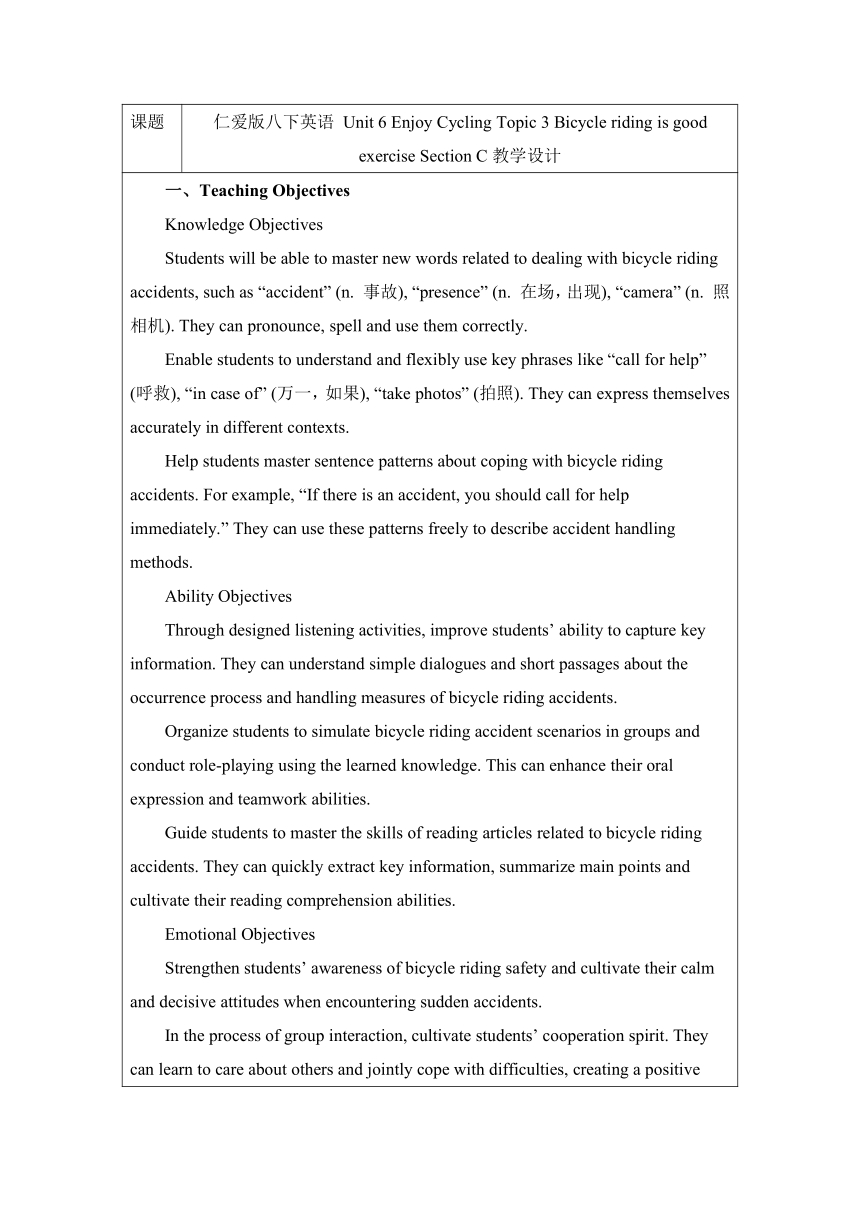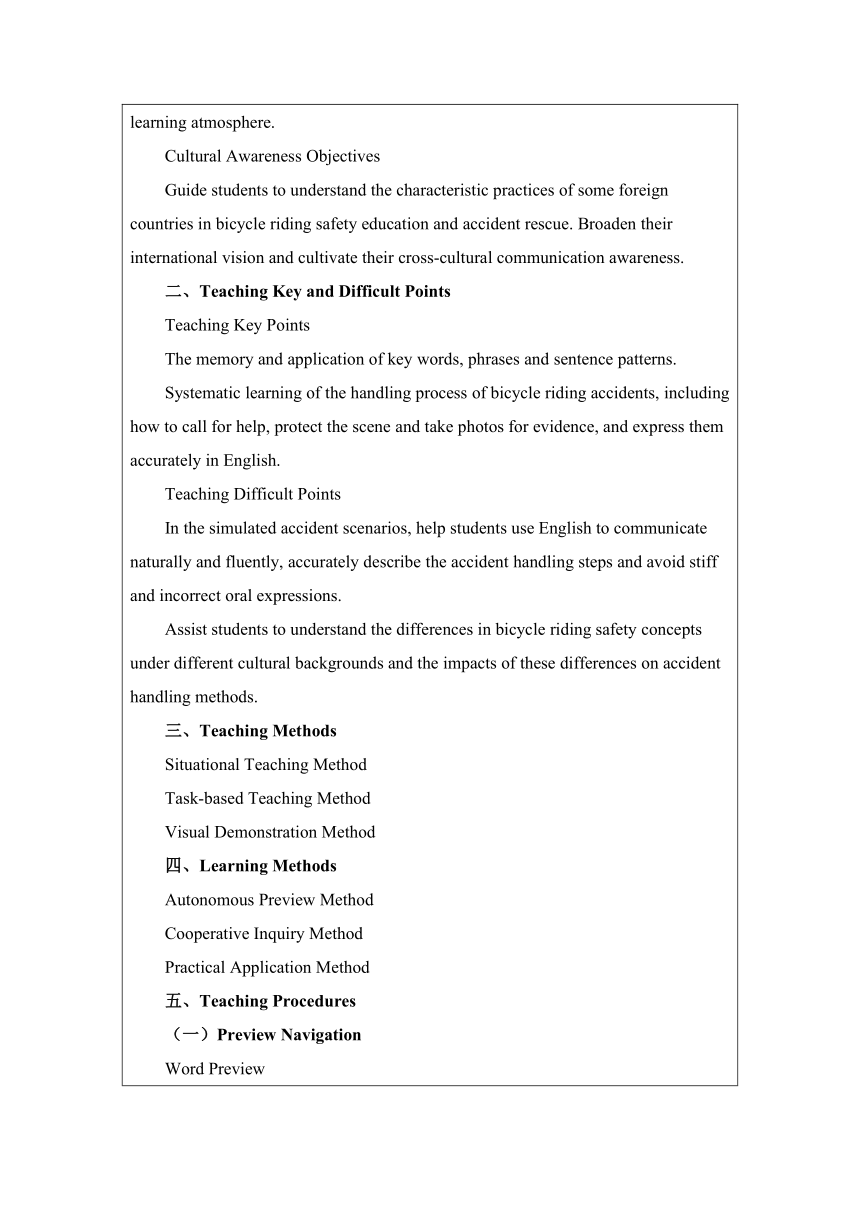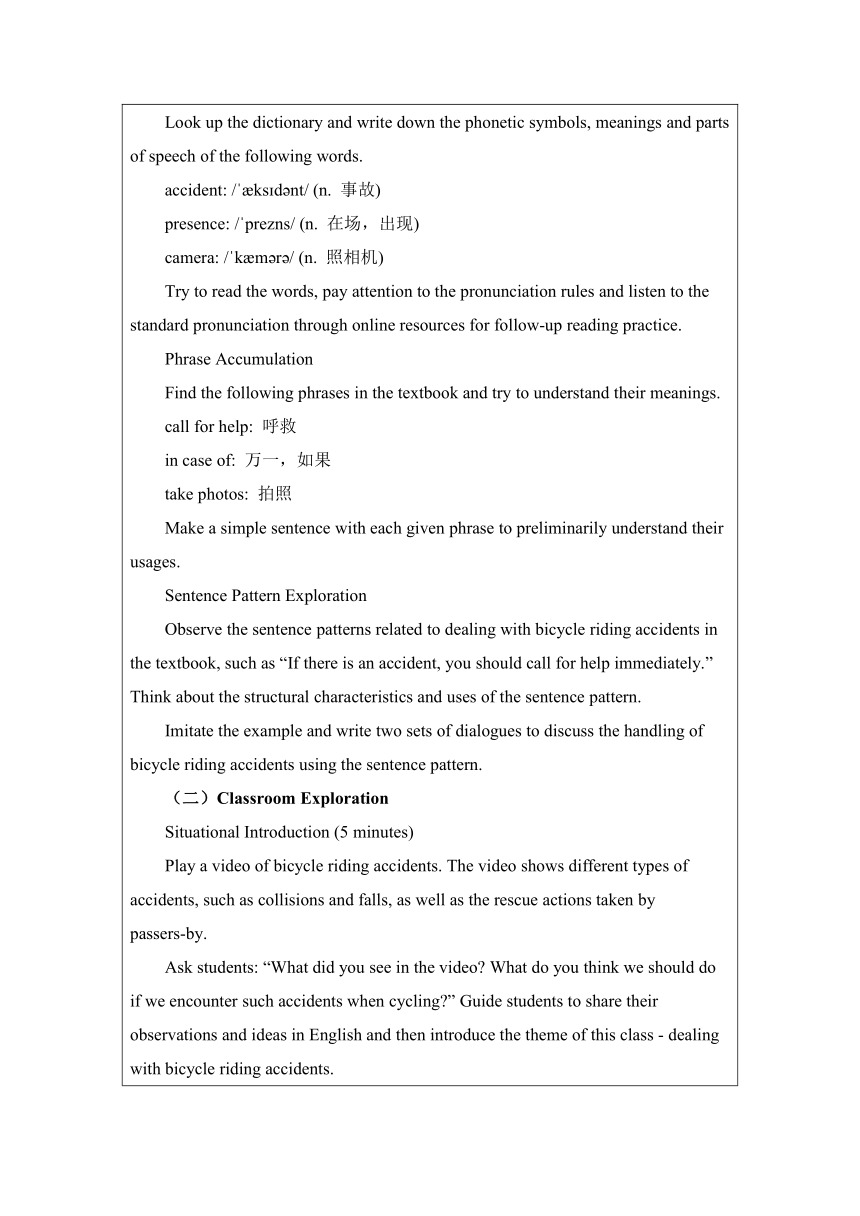仁爱版八年级下册 Unit 6 Enjoy Cycling Topic 3 Section C 教学设计(表格式)
文档属性
| 名称 | 仁爱版八年级下册 Unit 6 Enjoy Cycling Topic 3 Section C 教学设计(表格式) |  | |
| 格式 | docx | ||
| 文件大小 | 19.3KB | ||
| 资源类型 | 教案 | ||
| 版本资源 | 仁爱科普版 | ||
| 科目 | 英语 | ||
| 更新时间 | 2025-01-07 13:30:04 | ||
图片预览



文档简介
课题 仁爱版八下英语 Unit 6 Enjoy Cycling Topic 3 Bicycle riding is good exercise Section C教学设计
一、Teaching Objectives Knowledge Objectives Students will be able to master new words related to dealing with bicycle riding accidents, such as “accident” (n. 事故), “presence” (n. 在场,出现), “camera” (n. 照相机). They can pronounce, spell and use them correctly. Enable students to understand and flexibly use key phrases like “call for help” (呼救), “in case of” (万一,如果), “take photos” (拍照). They can express themselves accurately in different contexts. Help students master sentence patterns about coping with bicycle riding accidents. For example, “If there is an accident, you should call for help immediately.” They can use these patterns freely to describe accident handling methods. Ability Objectives Through designed listening activities, improve students’ ability to capture key information. They can understand simple dialogues and short passages about the occurrence process and handling measures of bicycle riding accidents. Organize students to simulate bicycle riding accident scenarios in groups and conduct role-playing using the learned knowledge. This can enhance their oral expression and teamwork abilities. Guide students to master the skills of reading articles related to bicycle riding accidents. They can quickly extract key information, summarize main points and cultivate their reading comprehension abilities. Emotional Objectives Strengthen students’ awareness of bicycle riding safety and cultivate their calm and decisive attitudes when encountering sudden accidents. In the process of group interaction, cultivate students’ cooperation spirit. They can learn to care about others and jointly cope with difficulties, creating a positive learning atmosphere. Cultural Awareness Objectives Guide students to understand the characteristic practices of some foreign countries in bicycle riding safety education and accident rescue. Broaden their international vision and cultivate their cross-cultural communication awareness. 二、Teaching Key and Difficult Points Teaching Key Points The memory and application of key words, phrases and sentence patterns. Systematic learning of the handling process of bicycle riding accidents, including how to call for help, protect the scene and take photos for evidence, and express them accurately in English. Teaching Difficult Points In the simulated accident scenarios, help students use English to communicate naturally and fluently, accurately describe the accident handling steps and avoid stiff and incorrect oral expressions. Assist students to understand the differences in bicycle riding safety concepts under different cultural backgrounds and the impacts of these differences on accident handling methods. 三、Teaching Methods Situational Teaching Method Task-based Teaching Method Visual Demonstration Method 四、Learning Methods Autonomous Preview Method Cooperative Inquiry Method Practical Application Method 五、Teaching Procedures (一)Preview Navigation Word Preview Look up the dictionary and write down the phonetic symbols, meanings and parts of speech of the following words. accident: / ks d nt/ (n. 事故) presence: / prezns/ (n. 在场,出现) camera: / k m r / (n. 照相机) Try to read the words, pay attention to the pronunciation rules and listen to the standard pronunciation through online resources for follow-up reading practice. Phrase Accumulation Find the following phrases in the textbook and try to understand their meanings. call for help: 呼救 in case of: 万一,如果 take photos: 拍照 Make a simple sentence with each given phrase to preliminarily understand their usages. Sentence Pattern Exploration Observe the sentence patterns related to dealing with bicycle riding accidents in the textbook, such as “If there is an accident, you should call for help immediately.” Think about the structural characteristics and uses of the sentence pattern. Imitate the example and write two sets of dialogues to discuss the handling of bicycle riding accidents using the sentence pattern. (二)Classroom Exploration Situational Introduction (5 minutes) Play a video of bicycle riding accidents. The video shows different types of accidents, such as collisions and falls, as well as the rescue actions taken by passers-by. Ask students: “What did you see in the video What do you think we should do if we encounter such accidents when cycling ” Guide students to share their observations and ideas in English and then introduce the theme of this class - dealing with bicycle riding accidents. New Knowledge Teaching (15 minutes) Vocabulary Learning Combine the video scenes and display the new words “accident”, “presence” and “camera” again. Explain their pronunciations, spellings, meanings and parts of speech in detail. Conduct a word chain game. The teacher says the first word and students say the next word in turn. They are required to say the pronunciation, meaning and part of speech and quickly make a sentence with the word to strengthen word memory. Ask students to describe the accident scenes in the video using the new words. For example, “There was an accident on the street. A cyclist fell off his bike.” to deepen their understanding and application of the words. Phrase and Sentence Pattern Learning The teacher uses multimedia courseware to display more accident scene pictures and combines examples to explain the usages of key phrases “call for help”, “in case of” and “take photos”. For example, “In case of a fire, we should call for help at once.” Divide students into groups for phrase filling exercises. The teacher patrols and guides, corrects mistakes. For the sentence pattern, the teacher demonstrates in the form of a dialogue. For example: A: What if we see an accident on the road B: If there is an accident, we should call for help immediately and take photos of the scene. Students imitate the practice in groups and the teacher listens and gives feedback. Listening Training (10 minutes) With the questions “What happened in the accident How did they deal with it ”, let students listen to the listening material of Section C 1a. In the first listening, focus on grasping the general idea of the dialogue. In the second listening, record key information while listening. After listening, quickly discuss the answers with the deskmate, compare the recorded contents and fill in the gaps. Play the listening again, read after the dialogue, imitate the pronunciation, intonation, liaison and weak forms. After reading twice, actively participate in role-playing reading to display the learning results and accept classmates’ evaluations to further improve oral expression. Group Work (10 minutes) Divide students into groups of four and discuss around the task of “simulating bicycle riding accident scenarios and handling”. Clarify the division of labor. Some play the injured, some play the rescuers, some are responsible for narration and some record the English errors and highlights in the discussion process. Use the learned vocabulary, phrases and sentence patterns to plan the accident handling process in detail. For example, how the rescuers call for help, how to check the condition of the injured and whether photos need to be taken for evidence. Encourage groups to add special situations, such as the injured being unconscious and traffic congestion at the scene, to make the simulated scenarios more realistic and challenging. Conduct a preview within the group and put forward modification suggestions to each other to improve the accident handling scheme. Achievement Display (2 minutes) Each group selects a representative to display the carefully simulated accident scenario and handling process to the whole class in English, explaining clearly and fluently. Other students listen carefully, record the advantages and disadvantages and prepare to make evaluation speeches. Learn from others’ strengths and reflect on the deficiencies of their own groups. Classroom Summary (3 minutes) Follow the teacher to review the key knowledge of this class: new words, phrases and sentence patterns, especially the key steps in dealing with bicycle riding accidents. Summarize the experience in the group cooperation process, praise the active and excellent groups and individuals and encourage other students to learn from them. Emphasize the importance of calm and correct handling when encountering bicycle riding accidents and let students keep it in mind. (三)After-class Expansion Written Homework Write a short passage describing a bicycle riding accident and its handling process using the learned knowledge. The passage should be no less than 80 words and cover the causes of the accident, the scene situation and handling measures. Pay attention to correct grammar and writing norms. After completion, students can use grammar books and dictionaries to check by themselves or ask their parents to help review, mark the errors and modify them carefully. Practical Homework After going home, communicate with family members in English about bicycle riding safety knowledge, especially sharing the accident handling methods learned in this class, such as “Call for help if there is an accident.” and jointly formulate a family bicycle riding safety plan. Share the experience with classmates in the next class.
一、Teaching Objectives Knowledge Objectives Students will be able to master new words related to dealing with bicycle riding accidents, such as “accident” (n. 事故), “presence” (n. 在场,出现), “camera” (n. 照相机). They can pronounce, spell and use them correctly. Enable students to understand and flexibly use key phrases like “call for help” (呼救), “in case of” (万一,如果), “take photos” (拍照). They can express themselves accurately in different contexts. Help students master sentence patterns about coping with bicycle riding accidents. For example, “If there is an accident, you should call for help immediately.” They can use these patterns freely to describe accident handling methods. Ability Objectives Through designed listening activities, improve students’ ability to capture key information. They can understand simple dialogues and short passages about the occurrence process and handling measures of bicycle riding accidents. Organize students to simulate bicycle riding accident scenarios in groups and conduct role-playing using the learned knowledge. This can enhance their oral expression and teamwork abilities. Guide students to master the skills of reading articles related to bicycle riding accidents. They can quickly extract key information, summarize main points and cultivate their reading comprehension abilities. Emotional Objectives Strengthen students’ awareness of bicycle riding safety and cultivate their calm and decisive attitudes when encountering sudden accidents. In the process of group interaction, cultivate students’ cooperation spirit. They can learn to care about others and jointly cope with difficulties, creating a positive learning atmosphere. Cultural Awareness Objectives Guide students to understand the characteristic practices of some foreign countries in bicycle riding safety education and accident rescue. Broaden their international vision and cultivate their cross-cultural communication awareness. 二、Teaching Key and Difficult Points Teaching Key Points The memory and application of key words, phrases and sentence patterns. Systematic learning of the handling process of bicycle riding accidents, including how to call for help, protect the scene and take photos for evidence, and express them accurately in English. Teaching Difficult Points In the simulated accident scenarios, help students use English to communicate naturally and fluently, accurately describe the accident handling steps and avoid stiff and incorrect oral expressions. Assist students to understand the differences in bicycle riding safety concepts under different cultural backgrounds and the impacts of these differences on accident handling methods. 三、Teaching Methods Situational Teaching Method Task-based Teaching Method Visual Demonstration Method 四、Learning Methods Autonomous Preview Method Cooperative Inquiry Method Practical Application Method 五、Teaching Procedures (一)Preview Navigation Word Preview Look up the dictionary and write down the phonetic symbols, meanings and parts of speech of the following words. accident: / ks d nt/ (n. 事故) presence: / prezns/ (n. 在场,出现) camera: / k m r / (n. 照相机) Try to read the words, pay attention to the pronunciation rules and listen to the standard pronunciation through online resources for follow-up reading practice. Phrase Accumulation Find the following phrases in the textbook and try to understand their meanings. call for help: 呼救 in case of: 万一,如果 take photos: 拍照 Make a simple sentence with each given phrase to preliminarily understand their usages. Sentence Pattern Exploration Observe the sentence patterns related to dealing with bicycle riding accidents in the textbook, such as “If there is an accident, you should call for help immediately.” Think about the structural characteristics and uses of the sentence pattern. Imitate the example and write two sets of dialogues to discuss the handling of bicycle riding accidents using the sentence pattern. (二)Classroom Exploration Situational Introduction (5 minutes) Play a video of bicycle riding accidents. The video shows different types of accidents, such as collisions and falls, as well as the rescue actions taken by passers-by. Ask students: “What did you see in the video What do you think we should do if we encounter such accidents when cycling ” Guide students to share their observations and ideas in English and then introduce the theme of this class - dealing with bicycle riding accidents. New Knowledge Teaching (15 minutes) Vocabulary Learning Combine the video scenes and display the new words “accident”, “presence” and “camera” again. Explain their pronunciations, spellings, meanings and parts of speech in detail. Conduct a word chain game. The teacher says the first word and students say the next word in turn. They are required to say the pronunciation, meaning and part of speech and quickly make a sentence with the word to strengthen word memory. Ask students to describe the accident scenes in the video using the new words. For example, “There was an accident on the street. A cyclist fell off his bike.” to deepen their understanding and application of the words. Phrase and Sentence Pattern Learning The teacher uses multimedia courseware to display more accident scene pictures and combines examples to explain the usages of key phrases “call for help”, “in case of” and “take photos”. For example, “In case of a fire, we should call for help at once.” Divide students into groups for phrase filling exercises. The teacher patrols and guides, corrects mistakes. For the sentence pattern, the teacher demonstrates in the form of a dialogue. For example: A: What if we see an accident on the road B: If there is an accident, we should call for help immediately and take photos of the scene. Students imitate the practice in groups and the teacher listens and gives feedback. Listening Training (10 minutes) With the questions “What happened in the accident How did they deal with it ”, let students listen to the listening material of Section C 1a. In the first listening, focus on grasping the general idea of the dialogue. In the second listening, record key information while listening. After listening, quickly discuss the answers with the deskmate, compare the recorded contents and fill in the gaps. Play the listening again, read after the dialogue, imitate the pronunciation, intonation, liaison and weak forms. After reading twice, actively participate in role-playing reading to display the learning results and accept classmates’ evaluations to further improve oral expression. Group Work (10 minutes) Divide students into groups of four and discuss around the task of “simulating bicycle riding accident scenarios and handling”. Clarify the division of labor. Some play the injured, some play the rescuers, some are responsible for narration and some record the English errors and highlights in the discussion process. Use the learned vocabulary, phrases and sentence patterns to plan the accident handling process in detail. For example, how the rescuers call for help, how to check the condition of the injured and whether photos need to be taken for evidence. Encourage groups to add special situations, such as the injured being unconscious and traffic congestion at the scene, to make the simulated scenarios more realistic and challenging. Conduct a preview within the group and put forward modification suggestions to each other to improve the accident handling scheme. Achievement Display (2 minutes) Each group selects a representative to display the carefully simulated accident scenario and handling process to the whole class in English, explaining clearly and fluently. Other students listen carefully, record the advantages and disadvantages and prepare to make evaluation speeches. Learn from others’ strengths and reflect on the deficiencies of their own groups. Classroom Summary (3 minutes) Follow the teacher to review the key knowledge of this class: new words, phrases and sentence patterns, especially the key steps in dealing with bicycle riding accidents. Summarize the experience in the group cooperation process, praise the active and excellent groups and individuals and encourage other students to learn from them. Emphasize the importance of calm and correct handling when encountering bicycle riding accidents and let students keep it in mind. (三)After-class Expansion Written Homework Write a short passage describing a bicycle riding accident and its handling process using the learned knowledge. The passage should be no less than 80 words and cover the causes of the accident, the scene situation and handling measures. Pay attention to correct grammar and writing norms. After completion, students can use grammar books and dictionaries to check by themselves or ask their parents to help review, mark the errors and modify them carefully. Practical Homework After going home, communicate with family members in English about bicycle riding safety knowledge, especially sharing the accident handling methods learned in this class, such as “Call for help if there is an accident.” and jointly formulate a family bicycle riding safety plan. Share the experience with classmates in the next class.
同课章节目录
- Unit 5 Feeling excited
- Topic 1 You look excited
- Topic 2 I’m feeling better now.
- Topic 3 Many things can affect our feelings.
- Unit 6 Enjoying Cycling
- Topic 1 We're going on a three-day visit to Mount
- Topic 2 How about exploring Tian’anmen Square?
- Topic 3 Bicycle riding is good exercise.
- Unit 7 Food festival
- Topic 1 We’re preparing for a food festival.
- Topic 2 I’m not sure whether I can cook it well.
- Topic 3 I Cooked the Most Successfully
- Unit 8 Our Clothes
- Topic 1 We will have a class fashion show.
- Topic 2 We can design our own uniforms.
- Topic 3 He said the fashion show was wonderful.
